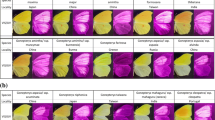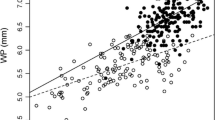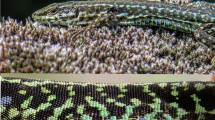Abstract
Pigmentation patterns, ultraviolet reflection and fluorescent emission are often involved in mate recognition and mate quality functions in many animal taxa. We investigated the role of wing ultra-violet reflection, fluorescence emission, and pigmentation on age and sexual signals in the damselfly Mnesarete pudica. In this species, wings are sexually dimorphic in colour and exhibit age dependency: males and females show a smoky black colouration when young, turning red in mature males while it turns brown in females. First, we investigated wing UV patterns through reflectance and emission spectra. Second, behavioural experiments were undertaken to show male and female responses to manipulated wing pigmentation and experimentally reduced UV (UV-). Reflectance spectra of the wings of juvenile and mature males and females were used to show the differences between controls and individuals with manipulated colouration used in the behavioural experiment. UV-reduced, females with wings painted red, and control males and females were tethered and presented to conspecific males and females, and their behavioral responses were recorded. The male red wing pigmentation and females with red wings elicited an aggressive response in territorial males and a sexual response in females. Both males and females showed neutral responses towards individuals with reduced UV. Wing signals of juvenile individuals also provoked neutral responses. These results suggest that UV, together with pigmentation, plays a role during mate recognition in males and females. Other than butterflies and spiders, it seems that fluorescence signals and UV reflectance can also be part of communication in odonates.




Similar content being viewed by others
References
Álvarez HA, Serrano–Meneses MA, Reyes–Márquez I, Jiménez–Cortés JG, Córdoba–Aguilar A (2013) Allometry of a sexual trait in relation to diet experience and alternative mating tactics in two rubyspot damselflies (Calopterygidae: Hetaerina). Biol J Linn Soc 108:521–533
Anderson M (1994) Sexual selection. Princeton University Press, Princeton
Anderson CN, Grether GF (2010a) Character displacement in the fighting colours of Hetaerina damselflies. Proc R Soc B 277:3669–3675
Anderson CN, Grether GF (2010b) Interspecific aggression and character displacement of competitor recognition in Hetaerina damselflies. Proc R Soc B 277:549–555
Appel E, Gorb SN (2011) Resilin-bearing wing vein joints in the dragonfly Epiophlebia superstes. Bioinspir Biomim 6:046006
Arnold KE, Owens IPF, Marshall NJ (2002) Fluorescent signaling in parrots. Science 295:92
Arnqvist G, Rowe L (2005) Sexual conflict. Princeton University Press, Princeton
Barreira AS, Lagorio MG, Lijtmaer DA, Lougheed SC, Tubaro PL (2012) Fluorescent and ultraviolet sexual dichromatism in the blue–winged parrotlet. J Zool 288:135–142
Bridge ES, Deaton MD (2005) Does ultraviolet reflection accentuate a sexually selected signal in terns? J Avian Biol 36:18–21
Briscoe AD, Chittka L (2001) The evolution of color vision in insects. Annu Rev Entomol 46:471–510
Bybee SM, Johnson KK, Gering EJ, Whiting MF, Crandall KA (2012) All the better to see you with: a review of odonate color vision with transcriptomic insight into the odonate eye. Org Divers Evol 12:241–250
Chapman RF (1998) The insects. Structure and function. Cambridge Univ. Press, Cambridge
Contreras-Garduno J, Buzatto BA, Serrano-Meneses MA, Najero-Cordero K, Córdoba-Aguilar A (2008) The size of the red wing spot of the American rubyspot as a heightened condition-dependent ornament. Behav Ecol 19:724–732
Corbet PS (1999) Dragonflies behaviour and ecology of Odonata. Harley Books, Essex
Cordero A (1987) Estructura de poblacion en Ischnura graellsii Rambur, 1842 (Zygop. Coenagrionidae). Bol Asoc Esp Entomol 11:269–286
Córdoba-Aguilar A (1993) Cambios en la coloracion en Matureos de Hetaerina americana (Rambur) (Odonata: Calopterygidae). Brenesia 39–40:181–183
Córdoba-Aguilar A (Ed.) (2008).Dragonflies and damselflies: model organisms for ecological and evolutionary research. OUP Oxford
Córdoba-Aguilar A (2009) A female evolutionary response when survival is at risk: male harassment mediates early reallocation of resources to increase egg number and size. Behav Ecol Sociobiol 63:751–763
Córdoba-Aguilar A, Cordero Rivera A (2005) Evolution and ecology of Calopterygidae (Zygoptera: Odonata): status of knowledge and research perspectives. Neotrop Entomol 34:861–879
Córdoba-Aguilar A, Salamanca-Ocaña JC, Lopezaraiza M (2003) Female reproductive decisions and parasite burden in a calopterygid damselfly (Insecta: Odonata). Anim Behav 66:81–87
Costa JM (1986) A especiação em Mnesarete pudica (Hagen in Selys, 1853) Cowley, 1934 com a descrição de uma nova subespécie (Odonata: Agrionidae). Bol Mus Nac Nova Sér, Zool 311:1–72
Darwin C (1874) The descent of man and selection in relation to sex. John Murray, London
Detto T, Backwell PR (2009) The fiddler crab Uca mjoebergi uses ultraviolet cues in mate choice but not aggressive interactions. Anim Behav 78:407–411
Doucet SM, Meadows MG (2009) Iridescence: a functional perspective. J R Soc Interface 6:S115–S132
Endler JA (1990) On the measurement and classification of color in studies of animal color patterns. Biol J Linn Soc 41:315–352
Farrant PA (1997) Colour in nature. Blandford, New York
Fincke OM (1994) Female dimorphism in damselflies: failure to reject the null hypothesis. Anim Behav 47:1249–1266
Fox DL (1976) Animal biochromes and structural colours. University of California Press, Berkeley
Gorb SN (1999) Serial elastic elements in the damselfly wing: mobile vein joints contain resilin. Naturwissenshaften 86:552–555
Gorb DJ, Kesel A, Berger J (2000) Microsculpture of the wing surface in Odonata: evidence for cuticular wax covering. Arthropod Struct Dev 29:129–135
Gorb SN, Tynkkynen K, Kotiaho JS (2009) Crystalline wax coverage of the imaginal cuticle in Calopteryx splendens (Odonata: Calopterygidae). Int J Odonatol 12:205–221
Grether GF, Kolloru GR, Nerisissian K (2004) Individual colour patches as multicomponent signals. Biol Rev 79:583–610
Guillermo-Ferreira R, Bispo PC (2012) Male and female interactions during courtship of the Neotropical damselfly Mnesarete pudica (Odonata: Calopterygidae). Acta Ethol 15:173–178
Heiling AM, Cheng K, Chittka L, Goeth A, Herberstein M (2005) The role of UV in crab spider signals: effects on perception by prey and predators. J Exp B 208:3925–3931
Hilton DFJ (1986) A survey of some Odonata for ultraviolet patterns. Odonatologica 15:335–345
Hooper RE, Tsubaki Y, Siva-Jothy MT (1999) Expression of a costly secondary sexual trait is correlated with age and condition in a damselfly with two male morphs. Physiol Entomol 24:364–369
Kemp DJ (2006) Heightened phenotypic variation and age-based fading of ultraviolet butterfly wing coloration. Evol Ecol Res 8:515–527
Kemp DJ (2007) Female mating biases for bright ultraviolet iridescence in the butterfly Eurema hecabe (Pieridae). Behav Ecol 19:1–8
Kemp DJ, Rutowski RL (2007) Condition dependence, quantitative genetics, and the potential signal content of iridescent ultraviolet butterfly coloration. Evolution 61:168–183
Kemp DJ, Herberstein ME, Grether GF (2012) Unraveling the true complexity of costly color signaling. Behav Ecol 23:233–236
Koskimäki J, Rantala MJ, Taskinen J, Tynkkynen K, Suhonen J (2004) Immunocompetence and resource holding potential in the damselfly, Calopteryx virgo L. Behav Ecol 15:169–173
Kuitunen K, Gorb SN (2011) Effects of cuticle structure and crystalline wax coverage on the coloration in young and old males of Calopteryx splendens and Calopteryx virgo. Zoology 114:129–139
Lim MLM, Li D (2006) Extreme ultraviolet sexual dimorphism in jumping spiders (Araneae: Salticidae). Biol J Linn Soc 89:397–406
Lim MLM, Li D (2007) Effects of age and feeding history on structure-based UV ornaments of a jumping spider (Araneae: Salticidae). Proc R Soc B 274:569–575
Lim MLM, Land MFL, Li DQ (2007) Sex-specific UV and fluorescence signals in jumping spiders. Science 315:481–481
Lim ML, Li J, Li D (2008) Effect of UV-reflecting markings on female mate-choice decisions in Cosmophasis umbratica, a jumping spider from Singapore. Behav Ecol 19:61–66
Lyon BE, Montgomerie RD (1986) Delayed plumage maturation in passerine birds: reliable signalling by subordinate males? Evolution 40:605–615
Mazel CH, Cronin TW, Caldwell RL, Marshall NJ (2004) Fluorescent enhancement of signaling in a mantis shrimp. Science 303:51–51
Miller MN, Fincke OM (1999) Cues for mate recognition and the effect of prior experience on mate recognition in Enallagma damselflies. J Insect Behav 12:801–814
Mougeot F, Martínez-Padilla J, Pérez-Rodríguez L, Bortolotti GR (2007) Carotenoid-based colouration and ultraviolet reflectance of the sexual ornaments of grouse. Behav Ecol Sociobiol 61:741–751
Nixon MR, Orr AG, Vukusic P (2013) Subtle design changes control the difference in colour reflection from the dorsal and ventral wing-membrane surfaces of the damselfly Matronoides cyaneipennis. Opt Express 21:1479–1488
Pajunen V (1966) Aggressive behavior and territoriality in a population of Calopteryx virgo L. (Odonata: Calopterygidae). Ann Zool Fenn 3:201–214
Pearn SM, Bennett AT, Cuthill IC (2001) Ultraviolet vision, fluorescence and mate choice in a parrot, the budgerigar Melopsittacus undulatus. Proc R Soc B 268:2273–2279
Pearn SM, Bennett AT, Cuthill IC (2003) The role of ultraviolet–A reflectance and ultraviolet–A–induced fluorescence in budgerigar mate choice. Ethology 109:961–970
Raihani G, Serrano-Meneses MA, Córdoba-Aguilar A (2008) Male mating tactics in the American rubyspot damselfly: territoriality, nonterritoriality and switching behaviour. Anim Behav 75:1851–1860
Rohwer S, Fretwell SD, Niles DM (1980) Delayed plumage maturation in passerine plumages and the deceptive acquisition of resources. Am Nat 115:400–437
Rutowski RL, Rajyaguru PK (2013) Male-specific iridescent coloration in the pipevine swallowtail (Battus philenor) is used in mate choice by females but not sexual discrimination by males. J Insect Behav 26:200–211
Rutowski RL, Nahm AC, Macedonia JM (2010) Iridescent hindwing patches in the Pipevine Swallowtail: differences in dorsal and ventral surfaces relate to signal function and context. Funct Ecol 24:767–775
Schultz TD, Fincke OM (2009) Structural colours create a flashing cue for sexual recognition and male quality in a Neotropical giant damselfly. Funct Ecol 23:724–732
Silsby J (2001) Dragonflies of the world. Smithsonian Institution Press, Washington
Siva-Jothy MT (1999) Male wing pigmentation may affect reproductive success via female choice in a calopterygid damselfly (Zygoptera). Behaviour 136:1365–1377
Stavenga DG, Leertouwer HL, Hariyama T, De Raedt HA, Wilts BD (2012) Sexual dichromatism of the damselfly Calopteryx japonica caused by a melanin-chitin multilayer in the male wing veins. PLoS One 7:e49743
Svensson EI, Karlsson K, Friberg M, Eroukhmanoff F (2007) Gender differences in species recognition and the evolution of asymmetric sexual isolation. Curr Biol 17:1943–1947
Vukusic P (2006) Structural colour in Lepidoptera. Curr Biol 16:621–623
Vukusic P, Sambles JR, Lawrence CR (2000) Structural colour: colour mixing in wing scales of a butterfly. Nature 404:457
Vukusic P, Wootton RJ, Sambles JR (2004) Remarkable iridescence in the hindwings of the damselfly Neurobasis chinensis (Linnaeus) (Zygoptera: Calopterygidae). Proc R Soc B 271:595–601
Waage JK (1975) Reproductive isolation and the potential for character displacement in the damselflies, Calopteryx maculata and C. aequabilis (Odonata: Calopterygidae). Syst Zool 24:24–36
Waage JK (1979) Reproductive character displacement in Calopteryx (Odonata: Calopterygidae). Evolution 33:104–116
Waage JK (1984) Female and male interactions during courtship in Calopteryx maculata and Calopteryx dimidiata (Odonata: Calopterygidae): influence of oviposition behavior. Anim Behav 32:400–404
Acknowledgments
We acknowledge Ana Carolina Vilarinho for field assistance. We thank Gregory Grether for valuable comments on the manuscript. RGF thanks CAPES (Coordenação de Aperfeiçoamento de Pessoal de nível Superior) for financial support. MHG thanks FAPESP (São Paulo Research Foundation) for financial support (projects 4617–6 and 8399–9) that allowed buildup of the fluorescence confocal microscope, and Professors Dr Johan Hofkens and Dr Kris P. F. Janssen for the use of the SIS software from MDS Laboratory of Department of Chemistry of Katholieke Universiteit Leuven. EMT and AM thanks to FAPEMIG (Minas Gerais Research Foundation), CAPES, CNPq (National Counsel of Technological and Scientific Development) and nanobio/INCT (National Institute of Science and Technology). PCB thanks to FAPESP (04/09711-8; 09/53233-7; 12/21196-8) and to CNPq (477349/2007-2; 301652/2008-2; 30757712011–2) for continuous support.
Author information
Authors and Affiliations
Corresponding author
Rights and permissions
About this article
Cite this article
Guillermo-Ferreira, R., Therézio, E.M., Gehlen, M.H. et al. The Role of Wing Pigmentation, UV and Fluorescence as Signals in a Neotropical Damselfly. J Insect Behav 27, 67–80 (2014). https://doi.org/10.1007/s10905-013-9406-4
Revised:
Accepted:
Published:
Issue Date:
DOI: https://doi.org/10.1007/s10905-013-9406-4




